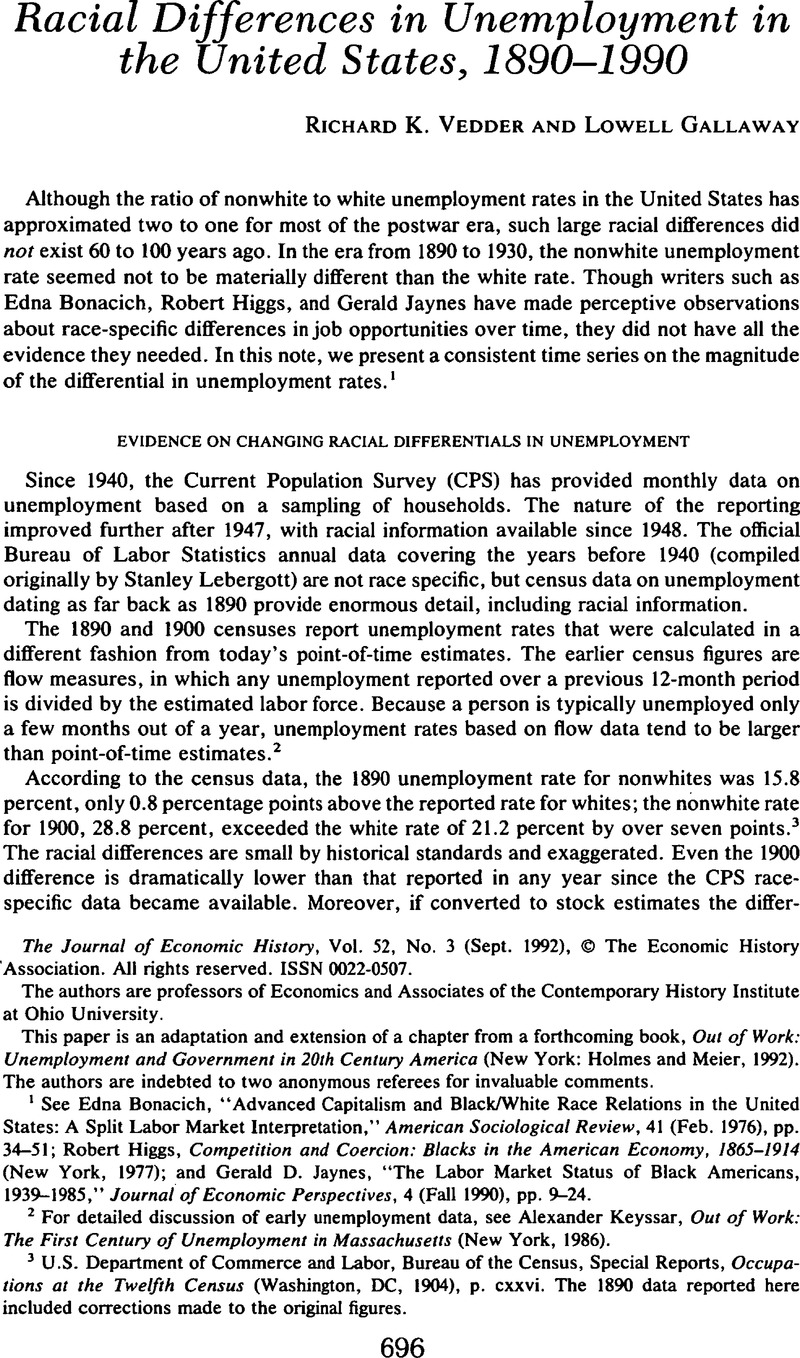Article contents
Racial Differences in Unemployment in the United States, 1890–1990
Published online by Cambridge University Press: 03 March 2009
Abstract

- Type
- Notes and Discussion
- Information
- Copyright
- Copyright © The Economic History Association 1992
References
1 See Bonacich, Edna, “Advanced Capitalism and Black/White Race Relations in the United States: A Split Labor Market Interpretation,” American Sociological Review, 41 (02 1976), pp. 34–51Google Scholar; Higgs, Robert, Competition and Coercion: Blacks in the American Economy, 1865–1914 (New York, 1977)Google Scholar; and Jaynes, Gerald D., “The Labor Market Status of Black Americans, 1939–1985,” Journal of Economic Perspectives, 4 (Fall 1990), pp. 9–24.Google Scholar
2 For detailed discussion of early unemployment data, see Keyssar, Alexander, Out of Work: The First Century of Unemployment in Massachusetts (New York, 1986).Google Scholar
3 U.S. Department of Commerce and Labor, Bureau of the Census, Special Reports, Occupations at the Twelfth Census (Washington, DC, 1904), p. cxxviGoogle Scholar. The 1890 data reported here included corrections made to the original figures.
4 Robert Margo observed a mean duration of unemployment in 1910 of 3.93 months. For his findings and procedures for estimating duration, see “The Incidence and Duration of Unemployment: Some Long-Term Consequences,” Economics Letters, 32 (03 1990), pp. 217–20.Google Scholar
5 In this calculation, some assumption had to be made about the distribution of the unemployed within each category of duration (for example, 1 to 3 months). We assumed a mean duration of unemployment of 1.6 months for those unemployed 1 to 3 months, 4.5 months for those unemployed 4 to 6 months, and 9.0 for those unemployed 7 to 12 months. Although changing the assumptions would materially change the reported absolute values, it would have a negligible effect on the ratio of nonwhite/white unemployment rates, the critical variable under investigation.
6 See U.S. Department of Commerce, Bureau of the Census, Historical Statistics of the United States, Colonial Times to 1970 (Washington, DC, 1975), p. 135.Google Scholar
7 For the underlying data leading to these estimates, see the U.S. Department of Commerce, Bureau of the Census, Fifteenth Census of the United States: 1930, Unemployment, vol. 2, General Report (Washington, DC, 1932), p. 235.Google Scholar
8 See Vedder, Richard and Gallaway, Lowell, Out of Work: Unemployment and Government in 20th Century America (New York, 1992)Google Scholar, chap. 5, for estimated monthly unemployment rates for the Depression era. These rates may all seem low, given that 1930 was a Depression year. It appears, however, that the census enumeration, completed in April, was taken at a time when the economy was recovering somewhat. Our estimate for April 1930 is 6.6 percent.
9 See U.S. Department of Commerce, Bureau of the Census, Sixteenth Census of the United States: 1940, Population, vol. 3, The Labor Force, Part I: United States Summary (Washington, DC, 1943), p. 18.Google Scholar
10 This may approach an upper-bound estimate of the migration impact. Adjusting the white labor force to the nonwhite geographic distribution (the opposite of the approach in the text), the estimated rise in the migration-adjusted nonwhite/white unemployment rate differential is greater, rising from 1.22 in 1930 to 1.76 in 1980. Using this approach, only 35 percent of the unadjusted rise in the differential is explainable by geographic mobility. Adjusting labor force distributions of both racial groups to that of the total population, however, yields a result close to that reported in the text.
11 In doing so, we switched to using the census rather than the CPS estimates for the postwar period. We were unable to average the 1900 and 1930 census results with respect to geographic distribution because the published race-specific unemployment data were not available for the earlier date.
12 John Cogan believes the decline in demand for agricultural labor played a major role in the decline in black teenage labor force involvement in the postwar era. See his “The Decline in Black Teenage Employment: 1950–70,” American Economic Review, 72 (09 1982), pp. 621–38.Google Scholar
13 For our thoughts about causes of the remaining increase in the race differential, see Vedder, and Gallaway, , Out of Work, chap 14.Google Scholar
We calculated the aggregate unemployment rate for further racial-ethnic divisions for 1930, observing significant differences: native whites, 6.05 percent; foreign-born whites, 9.20 percent; Negroes, 5.56 percent; other races, 7.77 percent. The Negro/native white unemployment rate differential, however, is 0.92, same as the nonwhite/white ratio reported above. The data seem broadly consistent with the McGouldrick-Tannen contention of immigrant employment discrimination. See McGouldrick, Paul F. and Tannen, Michael B., “Did American Manufacturers Discriminate Against Immigrants Before 1914?”, this Journal, 37 (09 1977), pp. 723–46Google Scholar. Also, cursory analysis suggests that adjusting the data for differential labor force participation by gender would change the reported values slightly.
- 31
- Cited by




